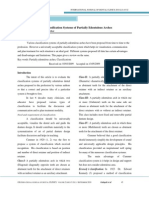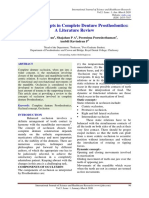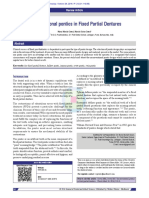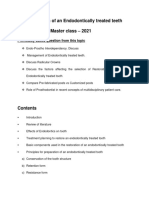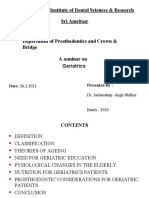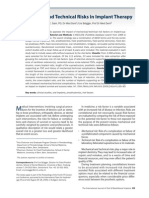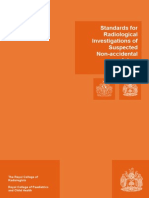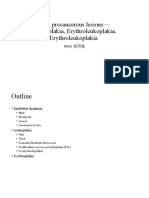Combination Syndrone
Combination Syndrone
Uploaded by
Amar BhochhibhoyaCopyright:
Available Formats
Combination Syndrone
Combination Syndrone
Uploaded by
Amar BhochhibhoyaOriginal Description:
Original Title
Copyright
Available Formats
Share this document
Did you find this document useful?
Is this content inappropriate?
Copyright:
Available Formats
Combination Syndrone
Combination Syndrone
Uploaded by
Amar BhochhibhoyaCopyright:
Available Formats
Sridharan Rajendran, Baburajan
156
Combination Syndrome
Sridharan Rajendran, Baburajan
REVIEW ARTICLE
10.5005/jp-journals-10019-1066
ABSTRACT
Combination syndrome (CS) is a dental condition that is
commonly seen in patients with a completely edentulous maxilla
and partially edentulous mandible with preserved anterior teeth.
This syndrome consists of severe anterior maxillary resorption
combined with hypertrophic and atrophic changes in different
quadrants of maxilla and mandible. This makes it a challenging
condition in dentistry that requires significant experience along
with advanced restorative and surgical skills. The causes of
maxillary bone resorption and ways to correct it are discussed
in this article. Conventional treatment with full upper and partial
lower dentures for the CS patients is not always adequate or
satisfying for patients and it often requires multiple remakes
due to continuing bone resorption. Dental implant rehabilitation
challenges conventional treatment with bone-anchoring
techniques to provide improved retention and stability for
implant-retained and supported prostheses. This article presents
a successful implant treatment of the partially edentulous maxilla
in CS patient. The necessity of a multidisciplinary approach for
early prevention and treatment of this complex condition is
emphasized. This article illustrates a review of the changes and
difficulties faced when treated with conventional approach which
can be overcome with the aid of implant-supported prosthesis.
Keywords: Combination syndrome, Resorbed maxilla, Flabby
tissue, Atrophic bone.
How to cite this article: Rajendran S, Baburajan. Combination
Syndrome. Int J Prosthodont Restor Dent 2012;2(4):156-160.
Source of support: Nil
Conflict of interest: None
INTRODUCTION
The glossary of prosthodontic terms defines combination
syndromes characteristic features that occur when an
edentulous maxilla is opposed by natural mandibular
anterior teeth, including loss of bone from the anterior
portion of the maxillary ridge, overgrowth of the
tuberosities, papillary hyperplasia of the hard palates
mucosa, extrusion of the lower anterior teeth and loss of
alveolar bone and ridge height beneath the mandibular
removable dental prosthesis basesalso called anterior
hyperfunction syndrome.
1,2
There may be seven characteristics associated with this
syndrome: (1) Bone loss in the premaxilla, (2) dropping of
the posterior maxilla (tuberosities), (3) extrusion of the lower
anterior teeth, (4) posterior bone loss in the mandible under
the RPD, (5) papillary hyperplasia of the maxilla,
(6) decreased occlusal vertical dimension and (7) facial
esthetics often altered dramatically.
Mechanics Which Produce the
Combination Syndrome
Negative pressure within the maxillary denture pulls the
tuberosities down by which the anterior ridge is driven
upward by the anterior occlusion thereby functional load
will then direct stress to the mandibular distal extension
resulting in bony resorption of the posterior mandibular
ridge, supraeruption of mandibular anteriors, occlusal plane
discrepancy, loss of vertical dimension of occlusion and
chronic stress results in an ill-fitting prosthesis.
3
Prevalence among denture patients: Among 150 patients
who had completed maxillary dentures and mandibular
anterior natural teeth, one in four demonstrated changes
consistent with the diagnosis of combination syndrome
(Shen and Gongloff 1989).
4
Classification of Combination Syndrome
Kelly was the first person to use the term combination
syndrome.
5
He believed that the key to many symptoms of
the combination syndrome (CS) is the early loss of bone
from the anterior part of the maxillary jaw.
3
The other
consistent features of this dental condition include
enlargement of maxillary tuberosities and mandibular
posterior bone resorption that can be present in many but
not all CS cases. Based on a literature review and the
authors experience with a variety of combination syndrome
patients (complete and partial maxillary and mandibular
edentulous cases), a clinically relevant classification of CS
is proposed. Three classes and 10 modifications of CS are
described below. An anterior maxillary resorption resulting
from the force of anterior mandibular teeth is the key feature
of this classification, and it is consistently present throughout
all classes and all modifications. Maxillary edentulous
condition defines the class, mandibular the modification
within the class. A treatment for each category of patients
with CS is suggested:
Class I: Maxilla: Completely edentulous alveolar ridge.
Mandible: Modification 1 (M1): Partially edentulous
ridge with preserved anterior teeth only. Modification
2 (M2): Stable fixed full dentition (natural teeth or
implant-supported crowns/bridges). Modification 3
(M3): Partially edentulous ridge with preserved teeth in
anterior and one posterior region.
Class II: Maxilla: Partially edentulous alveolar ridge
with teeth present in both posterior regions, edentulous
Combination Syndrome
International Journal of Prosthodontics and Restorative Dentistry, October-December 2012;2(4):156-160
157
IJOPRD
and atrophic anterior region. Mandible: Modifications
are the same as in class I (M1, M2 and M3).
Class III: Maxilla: Partially edentulous alveolar ridge
with teeth present in one posterior region only,
edentulous and atrophic anterior and one posterior region.
Mandible: Modifications are consistent with class I
and II (M1, M2, M3A and M3B) (Flow Charts 1 and 2).
This classification is based on what seems to be the
dominant feature of most CS casesan edentulous
premaxilla with an advanced resorption of anterior maxillary
bone and overgrowth of the anterior mandibular bone with
extrusion (supereruption) of lower front teeth.
Treatment
Systemic and Dental Considerations
Review medical and dental history.
Clinical and radiographic evaluation of both hard and
soft tissues.
Resolution of any inflammation, if present.
Evaluation of patient s caries susceptibility, periodontal
status and oral hygiene.
Factors to be considered in tooth to be used as abutment.
Kelly said that before proceeding with the prosthetic
treatment, gross changes that have already taken place
should be surgically treated. These include conditions like:
Flabby (hyperplastic) tissue
Papillary hyperplasia
Enlarged tuberosities
Lower partial denture base should be fully extended and
should cover retromolar pad and buccal-shelf area.
Treatment Planning
When planning treatment for patients with edentulous
maxillae and a partially edentulous mandible, the risk of
development of the CS must be recognized.
Basic Treatment Objective
Develop an occlusal scheme that discourages excessive
occlusal pressure on the maxillary anterior region, in both
centric and eccentric positions (Saunders et al, 1979).
Treatment planning for the completely edentulous
maxillary arch: Treatment modality should be using the
principle of restoring a stable posterior occlusion, while
minimizing occlusal pressures on the anterior maxilla.
Prevention of the combination syndrome must be our
primary objective. Planned extractions followed by
immediate dentures or preservation of a few of the remaining
teeth for the fabrication of overdenture prosthesis with a
metallic denture base for one arch are preferred treatment
modalities. This decreases the risk for occurrence of CS by
preventing a completely edentulous arch from opposing
natural teeth. For those patients in which CS has already
occurred, conventional prosthodontic techniques with
special consideration for flabby tissues must be followed
or else a multidisciplinary approach may be followed.
Surgical intervention (vestibuloplasty and excision of flabby
tissue) followed by a metallic denture base prosthesis is the
treatment of choice. Different patients with particular
clinical findings should be treated specifically to prostho-
dontically rehabilitate them and prevent combination
syndrome.
Flow Chart 1: Classification of CS
Sridharan Rajendran, Baburajan
158
Treatment option 1: Planned extractions followed by
immediate denturesthis treatment option is considered
when arch relationship negates an overdenture and requires
an alveolectomy along with extraction of the anterior teeth
for patients reporting with severe prognathic maxilla,
periodontally compromised proclined anterior teeth present
in the maxillary arch and missing mandibular posterior teeth.
The extractions of the maxillary anterior teeth were planned
along with the alveolectomy in the maxillary anterior region.
Hence, conventional immediate denture fabrication steps
were followed during primary and secondary impression
making, jaw relation recording, posterior try-in and mock.
Treatment option 2: Overdenture prosthesis with a metallic
denture baseevery effort should be made to avoid the
potentially destructive occlusal forces exerted on the anterior
maxillary residual ridge. Therefore, when a maxillary
complete denture is contemplated, endodontic and
periodontic techniques are used to preserve roots in order
to maintain the bony architecture of the anterior maxilla.
Treatment option 3: Conventional prosthodontic techniques
with special consideration for flabby tissuesa variety of
techniques have been suggested to circumvent the
difficulties of making a denture rest on flabby ridge. It has
been stated that while the flabby ridge may provide poor
retention for a denture, it is better than no ridge, as could
occur following surgical excision of the flabby tissues.
Treatment option 4: Surgical intervention (vestibuloplasty
and excision of flabby tissue) followed by metallic denture
base prosthesispatients reporting with a completely
edentulous maxillary arch opposing anterior natural
dentition in the mandibular arch along with destructive
changes in the hard and soft tissues of the jaws of the
combination syndrome, such as severe anterior ridge
resorption, epulis fissuratum and flabby tissue in the
maxillary arch accompanied by loss of vertical dimension
require surgical intervention.
Treatment Planning for the Distal Extension
Partially Edentulous Mandibular Arch
The main aim of prosthetic therapy is to restore stable
occlusion with good facial height. The main risk factors to
consider in the partial edentulous patients are associated
with the progression of periodontal disease, caries activity,
residual ridge resorption and functional problems. It is often
possible to stop progression of periodontal disease in the
elderly with conservative and surgical periodontal therapy;
and by instituting adequate hygiene measures. In this way
stable periodontal conditions can normally be established,
which are essential for an acceptable long-term prognosis
of reconstructive prosthodontic therapy. Different treatment
approaches have been advocated for the low-risk patients
who have not yet developed the combination syndrome and
with well-preserved mandibular anterior teeth and the high-
risk patients with destructive changes or supraerupted or
periodontally involved mandibular anterior teeth. The spatial
position of the mandibular anterior teeth is important to the
treatment plan.
Treatment option 1: Overdentureteeth that are
considerably supraerupted would require alteration by
shortening, crowning or placing them under an overdenture
to obtain a harmonious occlusion. The spatial position of
the mandibular anterior teeth is important to the treatment
plan. The level of the incisal edges of the mandibular anterior
teeth should be assessed in comparison to the proposed
posterior occlusal plane (Fig. 1).
Treatment option 2: A removable cast partial denture
Mouth preparation is done to support a removable cast
partial denture with an occlusal plane conducive to a bilateral
balanced articulation. The lingual plate delays the over-
eruption of the mandibular teeth, preventing undesirable
anterior pressure on the anterior part of the maxillary
denture. Optimum fit of the denture base of the removable
cast partial denture is achieved using the altered cast
technique. Posterior occlusal contact must be maintained
Flow Chart 2: Modifications of classes I and II
Combination Syndrome
International Journal of Prosthodontics and Restorative Dentistry, October-December 2012;2(4):156-160
159
IJOPRD
by constant relining of the distal extension denture base to
compensate for its resorption (Fig. 2).
Treatment option 3: Implant-supported fixed prosthesis
in distal extension partially edentulous situations implant-
supported fixed prosthesis may be used in case there is
adequate bone height and width, no anatomic structures that
Fig. 1: Lower overdenture with intracoronal retainers
could interfere with implant placement and visual inspection
and palpation do not show presence of any flabby excess
tissue, bony ridges and sharp underlying osseous formations
or undercuts. Either an implant can be placed distal to the
most posterior natural abutment and a fixed prosthesis
connecting the implant with the natural teeth can be
fabricated or two or more implants can be placed posterior
to the most distal natural tooth in order to fabricate a
completely implant-supported restoration (Fig. 3).
DISCUSSION
Different treatment approaches have been suggested for
patients with an edentulous maxilla and some remaining
anterior mandibular teeth. The choice of treatment ultimately
depends on the patient, the amount of time and money he is
willing to spend for the treatment, his oral condition and
his desire for fixed or removable prosthesis. Some patients
demand implants and some refuse them. Advantages of
implants compared to the conventional prosthodontics are
that implants stimulate the bone and maintain its dimension
similar to natural teeth.
6
Maxson et al
7
report similarities
between patients with overdentures constructed on
transmandibular implants that oppose complete maxillary
dentures, hence, only endosseous implants must be used.
Fig. 2: Lower precision attachments
Sridharan Rajendran, Baburajan
160
Fig. 3: Lower implant-supported complete denture
Implants provide a predictable method of tooth replacement
offering excellent functional and esthetic benefits.
Following the same prosthetic concepts for the maxilla as
existed in the mandible is not feasible. The long-term
prognosis for implants in the maxilla is less secure than
that of the edentulous mandible. Following tooth extraction
in the anterior part of the maxilla, horizontal bone resorption
is almost twice as pronounced as vertical resorption. The
reduced quantity and quality of bone in the maxilla together
with increased esthetic demands makes treatment planning
more complex. A different approach based on the ultimate
esthetic outcome is required compared to that of the
edentulous mandible, where function is the more critical
factor.
CONCLUSION
The evaluation of the risk of developing the combination
syndrome is based on dental history and the condition of
the remaining mandibular anterior teeth. High-risk patients
showing changes associated with the syndrome are more
likely to be those who stress the maxillary ridge, such as in
Angle class III jaw relationships, parafunctional habits and
in patients who have functioned mainly with mandibular
anterior teeth for long periods. The degenerative changes
that develop in the edentulous regions of wearers of
complete upper and partial lower dentures are almost
inevitable. The dentist must carefully plan the treatment of
these patients in order to maintain the health of the oral
tissues of these patients and provide them with prosthesis
that provide function but do not contribute to the
combination syndrome. Thorough diagnosis, planning and
implementation of treatment will result in an outstanding
outcome for both the patient and dentist.
REFERENCES
1. Kelly E. Changes caused by a mandibular removable partial
denture opposing a maxillary complete denture. J Prosthet Dent
1972;27(2):140-50.
2. Palmqvist S. The combination syndrome: A literature review-J
Prosthet Dent 2003;90(3),270-75.
3. Saunders T, Gillis Jr R, Desjardins R. The maxillary denture
opposing the mandibular bilaterall distal extension partial
denture. Treatment options. J Prosthet Dent 1979;41(2):124-28.
4. Koper A. The maxillary complete denture opposing natural teeth
problems and solutions. J Prosthet Dent 19878;57(6);704-07.
5. Schmitt S. Combination syndromea treatment approach. J
Prosthet Dent 1985;54(5):664-71.
6. Chee W, Jivraj S. Treatment planning of the edentulous
mandible. British Dent J 2006;201(6):337-48.
7. Maxson B, Powers M, Scott R. Prosthodontic considerations
for the transmandibular implant. J Prosthet Dent 1990;63(5):
554-58.
ABOUT THE AUTHORS
Sridharan Rajendran
Professor, Department of Prosthodontics, Chettinad Dental College
Chennai, Tamil Nadu, India
Baburajan (Corresponding Author)
Professor, Department of Prosthodontics, Mahatma Gandhi Dental
College, Puducherry, India, e-mail: drbaburajan@gmail.com
You might also like
- Border MouldingDocument13 pagesBorder MouldingSwati Pathak GiriNo ratings yet
- Implant ProsthodonticsDocument5 pagesImplant ProsthodonticsAmar BhochhibhoyaNo ratings yet
- Answers-Review Exercise An Outbreak of Enteritis During: Pilgrimage To MeccaDocument9 pagesAnswers-Review Exercise An Outbreak of Enteritis During: Pilgrimage To Meccayudha agustriNo ratings yet
- Linear OcclusionDocument8 pagesLinear OcclusionAmar BhochhibhoyaNo ratings yet
- Rosado-de-Christenson Localized Fibrous Tumors of The Pleura 2003Document25 pagesRosado-de-Christenson Localized Fibrous Tumors of The Pleura 2003JZNo ratings yet
- Cervical Incompetence Case StudyDocument25 pagesCervical Incompetence Case StudyKavi rajputNo ratings yet
- RH IncompatibilityDocument38 pagesRH IncompatibilitynamitaNo ratings yet
- 6.clinical Case ReportMultidisciplinary Approach For Rehabilitation of Debilitated Anterior ToothDocument6 pages6.clinical Case ReportMultidisciplinary Approach For Rehabilitation of Debilitated Anterior ToothSahana RangarajanNo ratings yet
- Orthodontically Driven Corticotomy: Tissue Engineering to Enhance Orthodontic and Multidisciplinary TreatmentFrom EverandOrthodontically Driven Corticotomy: Tissue Engineering to Enhance Orthodontic and Multidisciplinary TreatmentFederico BrugnamiNo ratings yet
- Technique To Fabricate Hollow Maxillary Complete DentureDocument4 pagesTechnique To Fabricate Hollow Maxillary Complete DentureBharath KondaveetiNo ratings yet
- Vertical Jaw Relation: V.S.HarishDocument17 pagesVertical Jaw Relation: V.S.HarishHarish VsNo ratings yet
- Abutment Selection in Fixed Partial Denture - A Review: Drug Invention Today January 2018Document6 pagesAbutment Selection in Fixed Partial Denture - A Review: Drug Invention Today January 2018Najeeb UllahNo ratings yet
- Anterior Deprogramming Device Fabrication Using A Thermoplastic Material PDFDocument3 pagesAnterior Deprogramming Device Fabrication Using A Thermoplastic Material PDFruli nurul amanNo ratings yet
- 8 Combination Syndrome: 8.1 Defining FeaturesDocument5 pages8 Combination Syndrome: 8.1 Defining FeaturesbabukanchaNo ratings yet
- Sequelae of Complete Denture WearingDocument16 pagesSequelae of Complete Denture WearingMayank AggarwalNo ratings yet
- Occlusal Splint Therapy-Review Article: March 2013Document12 pagesOcclusal Splint Therapy-Review Article: March 2013Riya KvNo ratings yet
- JInterdiscipDentistry3112-5456729 150927Document6 pagesJInterdiscipDentistry3112-5456729 150927Nisha GargNo ratings yet
- 5 DentogenicsDocument16 pages5 DentogenicsYuvraj KapoorNo ratings yet
- 41 220 1 PBDocument8 pages41 220 1 PBTejas KhaireNo ratings yet
- Overdenture AttachmentsDocument42 pagesOverdenture AttachmentsEmad Alryashi100% (1)
- Biological Considerations of Orientation, Vertical and Horizontal Jaw Relations in Complete Denture-First PartDocument43 pagesBiological Considerations of Orientation, Vertical and Horizontal Jaw Relations in Complete Denture-First PartArunNo ratings yet
- Minor Connector PDFDocument24 pagesMinor Connector PDFghanim alubeidiNo ratings yet
- Balanced Occlu HandoutDocument9 pagesBalanced Occlu HandoutMostafa FayadNo ratings yet
- Open-Cap Acrylic SplintDocument3 pagesOpen-Cap Acrylic SplintFeras Al-ZbounNo ratings yet
- 14) Stress Breaker - Stress EqualizerDocument12 pages14) Stress Breaker - Stress Equalizerطيبة نعمانNo ratings yet
- Retention Support Stability CDDocument53 pagesRetention Support Stability CDAshraf GebreelNo ratings yet
- A Review On Stresses-Induced by Removable Partial DenturesDocument5 pagesA Review On Stresses-Induced by Removable Partial DenturesKrupali JainNo ratings yet
- Silverman 1971Document19 pagesSilverman 1971Krupali JainNo ratings yet
- Masticatory EfficiencyDocument19 pagesMasticatory EfficiencyVikas AggarwalNo ratings yet
- Partial Retainer in FPD DR VikasDocument99 pagesPartial Retainer in FPD DR VikasVikas AggarwalNo ratings yet
- Impression Techniques in Implant Dentistry: Susanna S Brainerd, Dr. Bindu R NayarDocument12 pagesImpression Techniques in Implant Dentistry: Susanna S Brainerd, Dr. Bindu R NayarMaqbul AlamNo ratings yet
- CPD DesignDocument8 pagesCPD DesignMayuri PatilNo ratings yet
- R.P.I ConceptDocument6 pagesR.P.I ConceptVikas AggarwalNo ratings yet
- Rests: Rest SeatsDocument43 pagesRests: Rest Seatsreem eltyebNo ratings yet
- Impression Technique PDFDocument4 pagesImpression Technique PDFPremshith Cp100% (1)
- 7 Preventive ProsthodonticsDocument90 pages7 Preventive ProsthodonticsSugandhi PidaparthiNo ratings yet
- Dent Clin N Am 48 (2004) 397-416Document20 pagesDent Clin N Am 48 (2004) 397-416Akriti Goel100% (1)
- Recent Advancement in Complete Denture PDFDocument7 pagesRecent Advancement in Complete Denture PDFNoor MuhammadNo ratings yet
- Occlusal Concepts in Complete Denture Prosthodontics: A Literature ReviewDocument5 pagesOcclusal Concepts in Complete Denture Prosthodontics: A Literature ReviewSahana RangarajanNo ratings yet
- Non Rigid ConnectorsDocument4 pagesNon Rigid ConnectorsSupriya ShuklaNo ratings yet
- jc3 PDFDocument3 pagesjc3 PDFPradusha RevuruNo ratings yet
- Occlusion in CD - Aniket MoneDocument188 pagesOcclusion in CD - Aniket MoneAniket MoneNo ratings yet
- ImpressionDocument7 pagesImpressionAnnisa Nur AmalaNo ratings yet
- Implant Systems: Dr. Unjum Bashir, Dr. Manas Gupta, Dr. Ravish AhujaDocument7 pagesImplant Systems: Dr. Unjum Bashir, Dr. Manas Gupta, Dr. Ravish AhujaDr FarhatNo ratings yet
- Articulators-A Review Article: November 2014Document4 pagesArticulators-A Review Article: November 2014jancyNo ratings yet
- Conservative Mangement of Tilted AbutmentsDocument3 pagesConservative Mangement of Tilted Abutmentsrayavarapu sunilNo ratings yet
- Streamline Introduction of PonticsDocument0 pagesStreamline Introduction of PonticsAmar BhochhibhoyaNo ratings yet
- Occlusion in Complete DentureDocument64 pagesOcclusion in Complete Denturepuja singh100% (1)
- Maxillofacial Prosthetics Part-1 A Revie PDFDocument10 pagesMaxillofacial Prosthetics Part-1 A Revie PDFmehak malhotra100% (1)
- Principles of Tooth PreparationDocument69 pagesPrinciples of Tooth Preparationmegha bholaNo ratings yet
- 1 LD PDFDocument55 pages1 LD PDFbhupendraNo ratings yet
- Unconventional Pontics in Fixed Partial DenturesDocument5 pagesUnconventional Pontics in Fixed Partial DenturesAkanksha MahajanNo ratings yet
- Gypsum Products in ProsthodonticsDocument80 pagesGypsum Products in ProsthodonticsSruneerdha TNo ratings yet
- Hand Out 2021 Restoration of Endodontically Treated TeethDocument40 pagesHand Out 2021 Restoration of Endodontically Treated TeethpriyaNo ratings yet
- Diagnosis and Treatment Planning Part 1Document12 pagesDiagnosis and Treatment Planning Part 1Shahrukh ali khanNo ratings yet
- F Methods of Recording Centric Relation FinalDocument17 pagesF Methods of Recording Centric Relation FinalJyoti TripathiNo ratings yet
- Management of The Mandibular Compromised Ridge A Literature Review and Case ReportDocument5 pagesManagement of The Mandibular Compromised Ridge A Literature Review and Case ReportSorabh JainNo ratings yet
- 8-Mandibular MovementDocument46 pages8-Mandibular MovementSaifurahman TarakiNo ratings yet
- Sri Guru Ram Das Institute of Dental Sciences & Research Sri AmritsarDocument60 pagesSri Guru Ram Das Institute of Dental Sciences & Research Sri AmritsarKomal SaroyaNo ratings yet
- Evolution of Techniques in Recording Posterior Palatal Seal - A ReviewDocument5 pagesEvolution of Techniques in Recording Posterior Palatal Seal - A ReviewKrupali JainNo ratings yet
- Cantor and Curtis ClassificationDocument4 pagesCantor and Curtis ClassificationMuhammad AwaisNo ratings yet
- Diagnosis and Treatment Planning in FPDDocument109 pagesDiagnosis and Treatment Planning in FPDvergel john ErciaNo ratings yet
- Story: Submitted By: Siddartha Phaiju Class 6 Submitted To: D.R. Kattel SirDocument3 pagesStory: Submitted By: Siddartha Phaiju Class 6 Submitted To: D.R. Kattel SirAmar BhochhibhoyaNo ratings yet
- SPLNPROC Author Instructions - Feb2015 PDFDocument10 pagesSPLNPROC Author Instructions - Feb2015 PDFAmar BhochhibhoyaNo ratings yet
- Dental Materials PracticalDocument1 pageDental Materials PracticalAmar Bhochhibhoya100% (1)
- Ocular ProsthesisDocument3 pagesOcular ProsthesisAmar BhochhibhoyaNo ratings yet
- Comparison of Two Impression TechniqueDocument6 pagesComparison of Two Impression TechniqueAmar BhochhibhoyaNo ratings yet
- Dental Anxiety QuestionnairesDocument4 pagesDental Anxiety QuestionnairesAmar Bhochhibhoya100% (1)
- Mcqs DentistryDocument2 pagesMcqs DentistryAmar Bhochhibhoya100% (1)
- 16 Annual Dental Conference and Trade Exhibition January 31, 2015, KathmanduDocument2 pages16 Annual Dental Conference and Trade Exhibition January 31, 2015, KathmanduAmar BhochhibhoyaNo ratings yet
- Abrasive & Polishing AgentsDocument11 pagesAbrasive & Polishing AgentsVishal MalusareNo ratings yet
- Post Op InstructionsDocument5 pagesPost Op InstructionsAmar Bhochhibhoya0% (1)
- Balkwill's Angle For Complete DenturesDocument4 pagesBalkwill's Angle For Complete DenturesAnisha Mandavia Doshi0% (1)
- NotesDocument639 pagesNotesAmar Bhochhibhoya100% (1)
- Nepal Medical CouncilDocument3 pagesNepal Medical CouncilAmar BhochhibhoyaNo ratings yet
- Bio StaticsDocument93 pagesBio StaticsAmar BhochhibhoyaNo ratings yet
- Esthetics IllusionDocument8 pagesEsthetics IllusionAmar BhochhibhoyaNo ratings yet
- Complexity AssessmentDocument13 pagesComplexity AssessmentmariamNo ratings yet
- Complete Denture Selected TopicsDocument16 pagesComplete Denture Selected TopicsAmar BhochhibhoyaNo ratings yet
- Treatment PlanningDocument23 pagesTreatment PlanningAmar BhochhibhoyaNo ratings yet
- Sprue DesignDocument5 pagesSprue DesignAmar BhochhibhoyaNo ratings yet
- Implant ComplicationsDocument17 pagesImplant ComplicationsAmar BhochhibhoyaNo ratings yet
- Shortened ArchDocument5 pagesShortened ArchAmaey ParekhNo ratings yet
- Implant Supported ProsthesisDocument3 pagesImplant Supported ProsthesisAmar BhochhibhoyaNo ratings yet
- Disseminated Intravascular Coagulopathy Dic 1 1Document25 pagesDisseminated Intravascular Coagulopathy Dic 1 1api-394684626No ratings yet
- 04 GTTDocument15 pages04 GTTAshish TuraleNo ratings yet
- Case StudyDocument5 pagesCase StudyJui Perano100% (2)
- - اطلس جهاز التخدير-30-34Document5 pages- اطلس جهاز التخدير-30-34علي الاسديNo ratings yet
- Chapter 2: Food and Nutrition Igcse Revision Class 27/5/2021 11amDocument8 pagesChapter 2: Food and Nutrition Igcse Revision Class 27/5/2021 11americ sivaneshNo ratings yet
- ENLS Acute Ischemic Stroke ProtokolDocument23 pagesENLS Acute Ischemic Stroke ProtokolFransiskus MikaelNo ratings yet
- Thesis MedicineDocument110 pagesThesis MedicineVenkatesh Korapaka100% (3)
- Structural Disorders of The SpineDocument6 pagesStructural Disorders of The SpineRod Reynon BorceNo ratings yet
- 2020 NHSN Urinary Tract Infection (UTI) ChecklistDocument5 pages2020 NHSN Urinary Tract Infection (UTI) Checklistvani reddyNo ratings yet
- All Rights Reserved by Randall T. Monk. & Ronna Vezane orDocument3 pagesAll Rights Reserved by Randall T. Monk. & Ronna Vezane orCarlotaCastroNo ratings yet
- Prof. DR. Aboe Amar Joesoef, DR, Sp.S. (K)Document44 pagesProf. DR. Aboe Amar Joesoef, DR, Sp.S. (K)Ryan FeizalNo ratings yet
- InTech-Yamamoto New Scalp Acupuncture Ynsa Development Principles Safety Effectiveness and Clinical ApplicationsDocument17 pagesInTech-Yamamoto New Scalp Acupuncture Ynsa Development Principles Safety Effectiveness and Clinical Applicationsdasamoro100% (3)
- 08 Hirarc Form (r02)Document2 pages08 Hirarc Form (r02)Aizat Sera SuwandiNo ratings yet
- Vasa Praevia PDFDocument6 pagesVasa Praevia PDFAlwinNo ratings yet
- Non Accidental Injury GuidelinesDocument60 pagesNon Accidental Injury GuidelinesShahidatul Nadia SulaimanNo ratings yet
- Anti-Angiogenic Potential of Theobroma Cacao L. (Cacao) Seed Extract On Anas Platyrhynchos (Mallard Duck) EmbryoDocument41 pagesAnti-Angiogenic Potential of Theobroma Cacao L. (Cacao) Seed Extract On Anas Platyrhynchos (Mallard Duck) EmbryoJulienne Baldonado50% (2)
- Unit 3 Part 1 Introduction To Autoimmune DisordersDocument14 pagesUnit 3 Part 1 Introduction To Autoimmune DisordersReman AlingasaNo ratings yet
- Drug StudyDocument10 pagesDrug StudyRye IbarraNo ratings yet
- Health AssessmentDocument23 pagesHealth AssessmentPORTRAIT OF A NURSENo ratings yet
- TIẾP CẬN THEO VẤN ĐỀ TRONG CẤP CỨUDocument14 pagesTIẾP CẬN THEO VẤN ĐỀ TRONG CẤP CỨUThảo NguyễnNo ratings yet
- DR L M KhanDocument9 pagesDR L M KhanHomoeopath Aamir Saleem100% (5)
- Hazard and RiskDocument31 pagesHazard and RiskNadia ListianiNo ratings yet
- F (Med)Document3 pagesF (Med)Tapas DuttaNo ratings yet
- 紅白斑Document20 pages紅白斑b202104023 TMUNo ratings yet
- EdDowdPhinanceTechnologies ReportV DamageAnalysis NeuroDisease15 49 V3Document21 pagesEdDowdPhinanceTechnologies ReportV DamageAnalysis NeuroDisease15 49 V3doi gugutzaNo ratings yet
- Gallbladder Adenomyomatosis Imaging Findings, Tricks and PitfallsDocument11 pagesGallbladder Adenomyomatosis Imaging Findings, Tricks and PitfallsSamuel WidjajaNo ratings yet






















